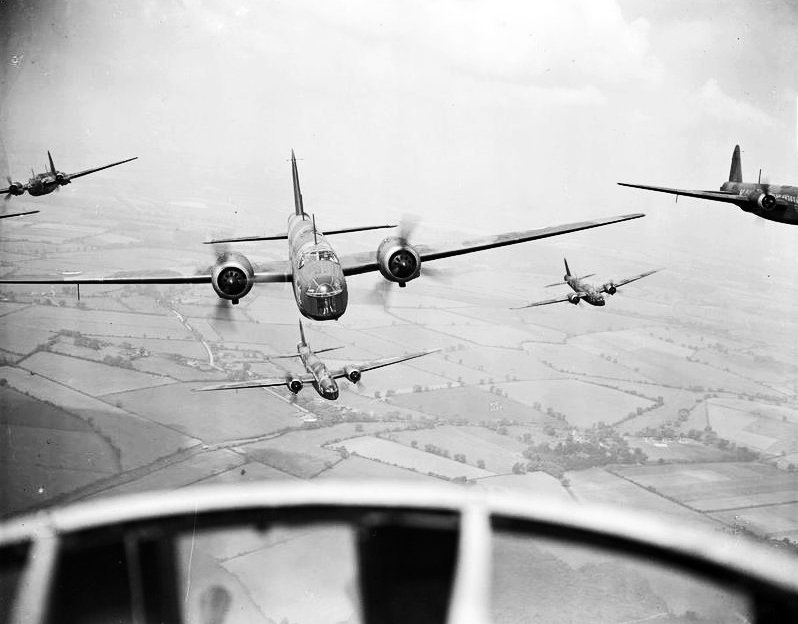On the night of May 30/31, 1942, 1047 bombers attacked Köln, despite the fact that it was pouring rain in England. This was possible to the perfect weather conditions in Germany at the time.
At the height of the Anglo-American strategic bombing campaign against Nazi Germany in the Second World War, Air Officer Commanding-in-Chief (AOC-in-C) of RAF Bomber Command was Marshal of the Royal Air Force (RAF), Sir Arthur Travers Harris, also known as “Bomber” Harris.
Harris planned to fly 1000 aircraft over a single target in a single night in an effort to accelerate the bomber campaign against Germany. The most that Bomber Command had ever accomplished on any given night was less than 300, as explained by Michael Napier in his book Vickers Wellington Units of Bomber Command, so a considerable amount of work would be required to execute the “thousand plan,” which had been code-named Operation Millennium. As many aircraft as could were prepared for operations by each squadron, and the OTUs (Operational Training Units) were also entrusted with supplying as many bombers as they could.
The night of May 30 and May 31, 1942, saw a total of 1047 bombers strike Köln, despite the fact that it rained heavily in England. This attack was made possible by the favorable weather conditions in Germany at the time. More than 600 Wellingtons, including 228 OTU bombers, targeted Köln that night. Wellingtons made up the majority of the aircraft. Many Wellington squadrons launched outstanding numbers of aircraft: No. 12 Sqn despatched 28 Wellingtons, the most the unit had ever sent out; No. 75 (NZ) Sqn had 23; No. 142 Sqn had 22; and No. 57 Sqn had 20. The bomber stream proceeded to the objective via Cromer and Dunkirk before returning via Vlissingen and Aldeburgh.
Little 103 Sqn, which dispatched 19 Wellingtons, reported that ‘visibility was good over route and target area, slight cloud only with a bright moon on the trip – aircraft had no difficulty in identifying the target, and little or no flak was encountered’. The moonlight and fires made it easy to see the River Rhine, the cathedral, and the bridges.
A combination of HE and incendiaries was carried on board the aircraft, with the former being used to blow off roofs so that the latter could fall inside and start fires. In total, 868 aircraft (496 of which were Wellingtons) were able to effectively assault the target. Most Wellington attacks occurred between 12,000 and 14,000 feet in the air. One crew from No. 9 Sqn stated that the ‘whole town was ablaze at 0115 hrs and fires were visible 100 miles after leaving. Fires visible from the Dutch coast from 10,000 ft on return’. Despite the fact that the German defenses were completely overrun by bombers, 29 Wellingtons did not return from the mission. On the return leg, one anonymous crew was spotted at 17,000 feet, ten miles south of Eindhoven. They described seeing ‘an ME 110 carrying no lights, traveling on a reciprocal course, slightly below, to port, at a distance of approximately 200 yards. There was no searchlight or flak activity at the time and IFF had not been used. Although our aircraft took normal evasive action, altering course 30° to port and starboard alternatively, ME 110 turned and closed in to attack from the starboard quarter at the same height. Our rear gunner, Sgt Dent, fired one seven‐second burst at 400 yards range and the enemy aircraft dived and was lost sight of temporarily.
‘Five minutes later ME 110 appeared once again on the starboard quarter and attacked our aircraft, closing in from 300 yards range, firing three short bursts of both machine gun and cannon. Our rear gunner replied and claimed, in which he is supported by the second pilot, to have secured “belly” hits at 80 yards range. Enemy aircraft dived from view and was not seen again. At this moment our aircraft went into an evasive dive from 17,000 ft to 12,000 ft so the enemy aircraft was not seen to crash, but it was probably damaged or destroyed.’
Plt Off D. M. Johnson (T2894), who had been temporarily attached to No 75 (NZ) Sqn from the Central Gunnery School at Sutton Bridge, was one of the OTU crews and personnel pulled in from other units to make up the numbers that night. The crew of Plt Off Ravenhill’s X3387 from No. 57 Sqn, which crashed at Lakenheath on the way back, and other severely damaged aircraft were safe.
Vickers Wellington Units of Bomber Command is published by Osprey Publishing and is available to order here.

Photo by The National Archives UK and Crown Copyright

